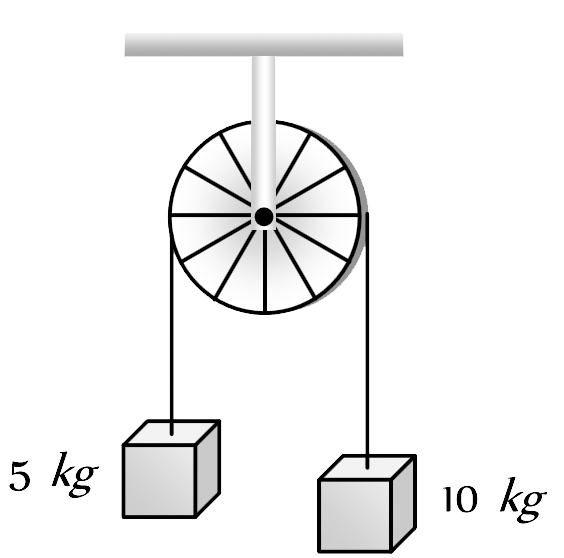A rocket fired from the earth's surface ejects 1% of its mass at a speed of 2000 ms−1 in the first second. Find the average acceleration of the rocket in the first second.Solution in Gujrati
For launching of rocket vdmDt−mg=ma⇒2000(m100)−m×10=ma⇒a=10ms−2
Topper's Solved these Questions
- NEWTONS LAWS OF MOTIONBOOK - ALLEN CHAPTER - NEWTONS LAWS OF MOTIONEXERCISE - EXERCISE-I
52 Videos
- NEWTONS LAWS OF MOTIONBOOK - ALLEN CHAPTER - NEWTONS LAWS OF MOTIONEXERCISE - EXERCISE-II
112 Videos
- NEWTONS LAWS OF MOTIONBOOK - ALLEN CHAPTER - NEWTONS LAWS OF MOTIONEXERCISE - EXERCISE-III
28 Videos
- NEWTON'S LAWS OF MOTION & FRICTIONBOOK - ALLEN CHAPTER - NEWTON'S LAWS OF MOTION & FRICTIONEXERCISE - EXERCISE (JA)
4 Videos
- RACEBOOK - ALLEN CHAPTER - RACEEXERCISE - Basic Maths (Wave Motion & Dopplers Effect) (Stationary waves & doppler effect, beats)
25 Videos
Similar Questions
USS 150) Two masses of 5 kg and 10 kg are connected to a pulley as shown. What will be the acceleration of the system (g= acceleration due to gravity)

View SolutionA particle is in straight line motion with uniform velocity A force is not required
View SolutionAssertion: The driver in a vechicle moving with a constant speed on a straight road is in a non-inertial frame of referance.
Reason: A reference frame in which Newton's laws of motion are applicable is non-inertial.
View SolutionA piece of wire is bent in the shape of a parabola y=kx2 (y-axis vertical) with a bead of mass m on it. The bead can slide on the wire without friction. It stays at the lowest point of the parabola when the wire is at rest. The wire is now accelerated parallel to the x-axis with a constant acceleration a. The distance of the new equilibrium position of the bead, where the bead can stay at rest with respect to the wire, from the y-axis is:
View SolutionThe frequency of a radar is 780 MHz. After getting reflected from an approaching aeroplane, the apparent frequency is more than the actual frequency by 2.6 kHz. The aeroplane has a speed of
View SolutionA rocket with an initial mass of 1000 kg , is launched vertically upward from rest under gravity. The rocket burns fuel at the rate of 10 kg per second. The burnt matter is ejected vertically downwards with a speed of 2000 m//s relative to the rocket . Find the velocity of the rocket after 1 min of start.
View SolutionA rocket is set for vertical firing If the exhaust speed is 1200ms−1 , how much gas must be ejected per second to supply the thrust needed (i) to overcome the weight of rocket (ii) to give to the rocket an initial vertical upward acceleration of 29.6m/s2 Given mass of rocket = 6000 kg.
View SolutionIn the first second of its flight a rocket ejects 160 of its mass with a reative velocity 2073ms−1 What is the initial acceleration of the rocket ? .
View SolutionA 600 kg rocket is set for a vertical firing. If the exhaust speed is 1000 ms^(-1) , the mass of the gas ejected per second to supply the thrust needed to overcome the weight of rocket is
View SolutionA rocket is fired upward from the earth's surface such that it creates an acceleration of 19.6 m/sec . If after 5 sec its engine is switched off, the maximum height of the rocket from earth's surface would be
View SolutionA 6000 - kg rocket is set for firing . If the exhaust speed is 1000ms−1 , how much gas must be ejected per second to supply the thrust needed , (a) to overcome the weight of the rocket , (b) to give the rocket an initial acceleration of 19.6ms−2?
View SolutionA Diwali rocket is ejecting 5 gram of gases/second at a velocity of 4m/s. What is the accelerating force acting on the rocket?
View Solutionपृथ्वी तल से दागा गया रॉकेट पहले सेकंड में अपने द्रव्यमान का 1% , 2000 मी/से के वेग से उत्सर्जित करता है । पहले सेकंड में रॉकेट का माध्य त्वरण ज्ञात कीजिए ।
View SolutionRocket in the first second of its flight, 2400 मी/ /से^(-1) Velocity of its mass 1//60 Leaves part. Rocket acceleration are
View SolutionA 3000 kg rocket is fired. If the exhaust speed is 500 ms^(-1) , how much gas must be ejected per second to supply the thrust needed, (a) to overcome the weight of the rocket, (b) to give the rocket an initial acceleration of 19.6 ms^(-2) ?
View SolutionA 3000 kg rocket is fired. If the exhaust speed is 500 ms−1, how much gas must be ejected per second to supply the thrust needed, (a) to overcome the weight of the rocket, (b) to give the rocket an initial acceleration of 19.6 ms−2 ?
View Solution
